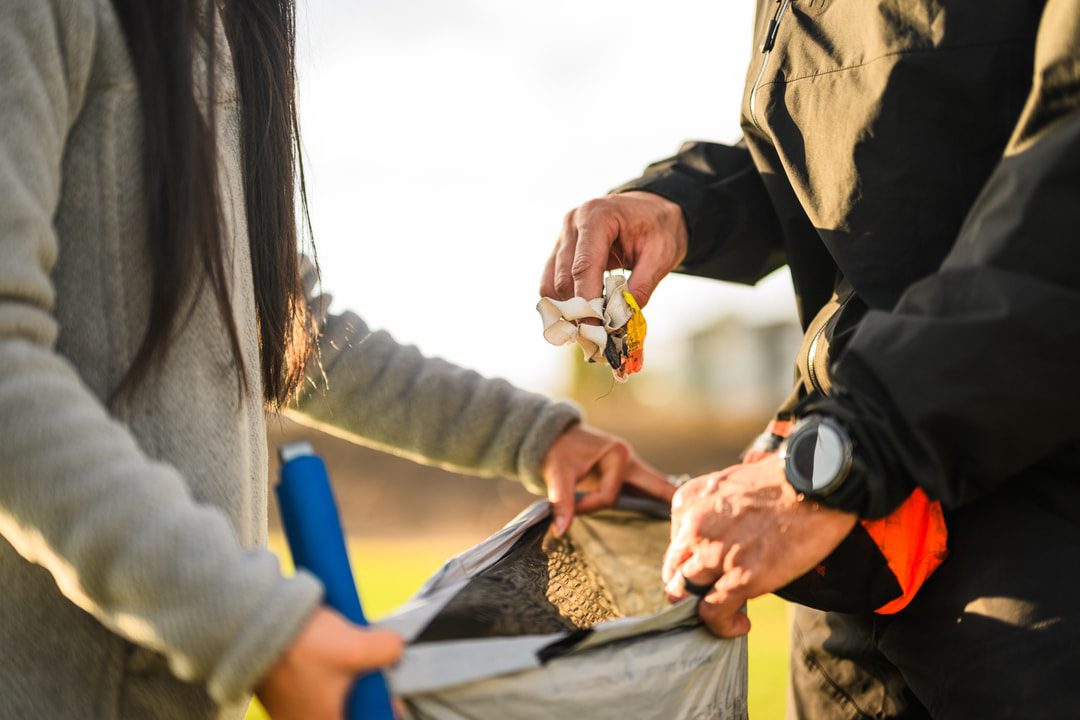Words by Paige Rohwer
Visitors from all over the world visit San Diego’s beaches year round, and upon first glance they look pristine. However, the sand, parking lots, and grassy parks that make up our beaches—not to mention the inland trails and waterways—carry hundreds of cigarette butts, microplastics, styrofoam fragments, textiles, nurdles, and other debris. This refuse starts off as litter or improperly disposed of waste, and accumulates in ecologically sensitive coastal areas as it gets picked up by stormwater and urban runoff, or other events like wind storms.
To address this problem, San Diego Coastkeeper hosts different types of volunteer cleanups (community-based, corporate-sponsored, and virtual) and lends out cleanup supplies to the public all throughout the year. The goal of these efforts is to empower community members to help clean and maintain local beaches, neighborhoods, and parks to reduce the amount of trash that infiltrates San Diego’s inland and coastal waters.
Coastkeeper’s beach cleanup initiatives are so important for environmental and community health because the beach is the last stop before the debris makes its way into the ocean. If trash makes it past our beaches and into the ocean, the pollution begins degrading marine ecosystems and is incredibly difficult to remove from the environment.
Structure and Importance of Coastkeeper Beach Cleanups
In addition to collecting trash, community volunteers at Coastkeeper cleanups help to record the type and amount of trash collected, and the total weight of what is removed. Some of the most common types of debris include:
- Cigarette butts
- Plastic straws
- Wrappers
- Take-out utensils
- Plastic bottles
- Wood
- Aluminum
- Extruded polystyrene foam (Styrofoam)
- Fishing gear
- Biodegradables
Coastkeeper then compiles the data collected to create annual Marine Debris Reports which are available to the public.
These cleanup events would not be successful without the participation and efforts of community volunteers. Community participation brings awareness and makes the work more meaningful and empowering, because volunteers have the opportunity to impact areas that are valuable and important to them, areas that are favorite places to spend a sunny day, take the family when they come to visit, walk the dog, go for a surf—places that make San Diego one of the most desirable cities to live.
Analysis of the volunteers’ data allows Coastkeeper to determine the type, levels, and sources of pollution at San Diego’s beaches, and determine what steps need to be taken to address it. In addition to monitoring, this data informs San Diego Coastkeeper’s science, education, outreach, litigation, and advocacy work.
How Clean Has 2024 Been?
At the time of writing this—about half way through 2024—more than 4,600 pounds of trash has been collected by over 945 volunteers, over the course of 21 beach cleanups hosted by San Diego Coastkeeper alone. From the community data collected, we are able to decipher what our measurable impact is for the first half of this year.
A look at the numbers:


Deeper Issues
These debris removal events are impactful, because many man-made materials either photodegrade, meaning they need sunlight to break down, or do not completely biodegrade, meaning they stay in the environment for a very long time. (NOAA)
Once in the ocean, materials that photodegrade do not receive enough sunlight, extending their lifespan and impact on marine ecosystems. Ocean currents carry large amounts of trash for hundreds and thousands of miles, often accumulating debris in massive collections, like the Great Pacific Garbage Patch, located in the North Pacific Ocean (National Geographic).
But a substantial amount of marine debris falls to the ocean floor. This issue is only getting worse, and the extent to which marine pollution affects the environment is not yet fully known. What is well understood is that plastic can harm marine life through ingestion, trapping and entanglement, and toxicity. Long term impacts could be even more detrimental. Humans need to be aware of the effect they have on the environment, and take steps to limit it. Coastkeeper’s beach cleanups not only help to decrease the amount of trash in local waters, but also increase marine debris awareness among the public, fighting the issue on two fronts.
Beach cleanups are often many people’s first experience with environmentalism. Participating in cleanups is fun, helpful, and instills much-needed awareness about how much trash is being produced and disposed of. It also opens the doors to ways individuals can reduce pollution in their daily lives, potentially influencing better habits like avoiding single-use plastics and disposing of trash properly. One can be aware of the trash they produce and how they dispose of it, pick up trash wherever they see it if safe, and encourage others to make similar choices.
Getting Involved
Participating in Coastkeeper cleanups is a simple, effective way for individuals or groups to help improve the health of San Diego’s coastal ecosystems. Increasing volunteer turnout year over year is important because hosting more volunteers increases the potential recovered debris during each event.
A list of Coastkeeper events can be found here. For those interested in the annual data, our 2024 marine debris report will be published in full early next year.

















